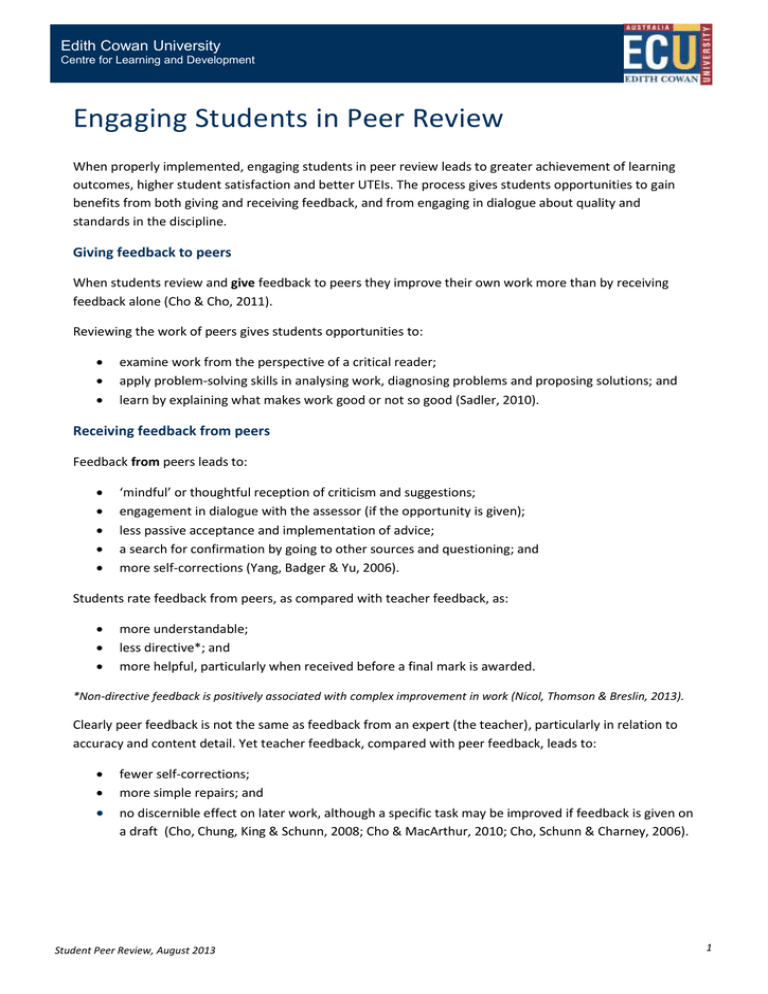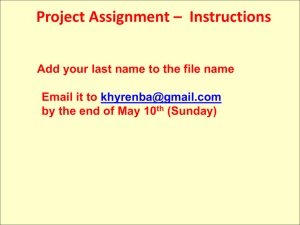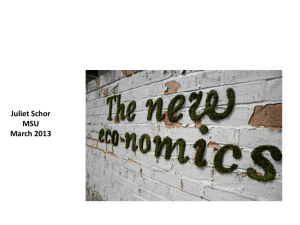Student Peer Review - Edith Cowan University
advertisement

Edith Cowan University Centre for Learning and Development Engaging Students in Peer Review When properly implemented, engaging students in peer review leads to greater achievement of learning outcomes, higher student satisfaction and better UTEIs. The process gives students opportunities to gain benefits from both giving and receiving feedback, and from engaging in dialogue about quality and standards in the discipline. Giving feedback to peers When students review and give feedback to peers they improve their own work more than by receiving feedback alone (Cho & Cho, 2011). Reviewing the work of peers gives students opportunities to: examine work from the perspective of a critical reader; apply problem-solving skills in analysing work, diagnosing problems and proposing solutions; and learn by explaining what makes work good or not so good (Sadler, 2010). Receiving feedback from peers Feedback from peers leads to: ‘mindful’ or thoughtful reception of criticism and suggestions; engagement in dialogue with the assessor (if the opportunity is given); less passive acceptance and implementation of advice; a search for confirmation by going to other sources and questioning; and more self-corrections (Yang, Badger & Yu, 2006). Students rate feedback from peers, as compared with teacher feedback, as: more understandable; less directive*; and more helpful, particularly when received before a final mark is awarded. *Non-directive feedback is positively associated with complex improvement in work (Nicol, Thomson & Breslin, 2013). Clearly peer feedback is not the same as feedback from an expert (the teacher), particularly in relation to accuracy and content detail. Yet teacher feedback, compared with peer feedback, leads to: fewer self-corrections; more simple repairs; and no discernible effect on later work, although a specific task may be improved if feedback is given on a draft (Cho, Chung, King & Schunn, 2008; Cho & MacArthur, 2010; Cho, Schunn & Charney, 2006). Student Peer Review, August 2013 1 Edith Cowan University Centre for Learning and Development How can we develop effective, sustainable peer review and feedback processes? 1. Let students in on our secret We become skilled at making informed judgements about student work because we practise all the time, comparing student work, engaging in dialogue with colleagues and justifying grades to students. When we ask students to review the work of a peer and give feedback we begin to let them in to our secret world and its processes of assessment 2. Emphasise holistic judgement processes Encourage students to evaluate work in terms of the overall purpose of the task, and to give feedback on specific aspects of work in the context of the task purpose (Bloxham, 2013). 3. Be open about the complexity of professional judgement In our effort to make standards transparent for students we have developed a habit of representing them through rubrics. We need to acknowledge that the process of making professional judgements cannot be fully represented by criteria or rubrics. The truth is that these published criteria don’t reflect the way we actually make judgements (Brooks, 2009). 4. Be honest about our own process In practice we actually we tend to work backwards from holistic judgements, awarding marks to individual criteria later, or using criteria to check or confirm holistic judgement (Grainger, Purnell, & Zipf, 2008; Bloxham, Boyd, & Orr, 2011). We need to teach students to work this way – from holistic to particular, giving them opportunities to explain holistic judgements by drawing on criteria. 5. Encourage dialogue about quality and standards Student involvement in making holistic judgements, often using exemplars of previous students’ work at various standards, can initiate dialogues that give students access to the tacit knowledge of experts (Handley & Williams, 2011; Sambell, Barry-Cutter, & Price, 2011). 6. Be honest about judgement Professional judgement has the potential for legitimate individual difference. Different perspectives can be used to foster dialogue in which criteria are invoked to explain judgements. This will make students more critical and engaged users of feedback and lead to learning that lasts beyond an immediate task. 7. Redefine feedback Most students see feedback as only the written comments they get on an assignment the lecturer has marked and returned to them. Such a limited view of feedback excludes the dialogic process promoted by Nicol (2010). The informal processes of peer interaction (chats between students) offer excellent learning opportunities, often in a relaxed environment – exactly the environment conducive to deep learning (Sambell, et al., 2011). 8. Shift the locus of control to learners Feedback is too often based on what the teacher wants to say rather than on what the student is ready to hear. Students engaged in peer review experience greater feelings of autonomy and control (Carless, 2013). They also develop self-evaluative capacities so that they are able to continue improving and become autonomous, self-regulating learners. Student Peer Review, August 2013 2 Edith Cowan University Centre for Learning and Development 9. Redefine the teacher’s role Implementing peer review and feedback changes the teacher role from someone who mainly provides comments on student progress, to one of supporting students to make their own professional judgements (Carless, 2013). The instruction becomes less teacher-centred. 10. Create a classroom culture of openness and trust It is important to spend time on creating a classroom culture of support and understanding before attempting to implement a peer feedback system. Students are only ready to engage with a peer feedback process when they: feel comfortable with each other and the teacher; feel supported by their peers; respect each other’s opinions; and feel willing to take risks and make mistakes (Glasson, 2009). What can be done to create a supportive classroom culture? Implement in-class activities requiring cooperation and support (class meetings, games, roleplays); Attend to physical classroom layout (conducive to collaborative work); Explain why peer review is being introduced and how it benefits students; Provide explicit instruction about how to give and receive feedback; Value mistakes (So everyone’s work was perfect? That was a waste of time!); Respect individuals’ desire for privacy – ask for volunteers to share feedback, don’t insist; Insist that all views are listened to respectfully; and Use models or exemplars to practice with (Glasson, 2009). Feedback is central to the scholarship of assessment (Rust, 2007) as it helps students to understand standards, gauge their own achievement in relation to those standards, and identify ways of bridging the gap (Sadler, 1989). We can engage students in the scholarship of assessment by positioning assessment and feedback as learning activities that are integral to developing the professional judgement that will be required by them in their future careers. Student Peer Review, August 2013 3 Edith Cowan University Centre for Learning and Development References Bloxham, S. (2013). Building 'standards' frameworks: The role of guidance and feedback in supporting the achievement of learners. In S. Merry, M. Price, D. Carless & M. Taras (Eds.), Reconceptualising Feedback in Higher Education: Developing dialogue with students. London: Routledge. Bloxham, S., Boyd, P., & Orr, S. (2011). Mark my words: the role of assessment criteria in UK higher education grading practices. Studies in Higher Education, 36(6), 655-670. DOI: 10.1080/03075071003777716 Brooks, V. (2012). Marking as judgment. Research Papers in Education, 27(1), 63-80. DOI: 10.1080/02671520903331008 Carless, D. (2013). Sustainable feedback and the development of student self-evaluative capacities. In S. Merry, M. Price, D. Carless & M. Taras (Eds.), Reconceptualising Feedback in Higher Education: Developing dialogue with students. London: Routledge. Cho, Y. H., & Cho, K. (2011). Peer reviewers learn from giving comments. Instructional Science, 39(5), 629-643. DOI: 10.1007/s11251-010-9146-1 Cho, K., Chung, T. R., King, W. R., & Schunn, C. (2008). Peer-based computer-supported knowledge refinement: An empirical investigation. Communications of the ACM, 51(3), 83-88. DOI: 10.1145/1325555.1325571 Cho, K., & MacArthur, C. (2010). Student revision with peer and expert reviewing. Learning and Instruction, 20(4), 328338. DOI: 10.1016/j.learninstruc.2009.08.006 Cho, K., Schunn, C. D., & Charney, D. (2006). Commenting on writing typology and perceived helpfulness of comments from novice peer reviewers and subject matter experts. Written Communication, 23(3), 260-294. DOI: 10.1177/0741088306289261 Glasson, T. (2009). Improving Student Achievement: A practical guide to assessment for learning. Curriculum Corporation, Victoria, Australia. Grainger, P., Purnell, K., & Zipf, R. (2008). Judging quality through substantive conversations between markers. Assessment & Evaluation in Higher Education, 33(2), 133-142. DOI: 10.1080/02602930601125681 Handley, K., & Williams, L. (2011). From copying to learning: Using exemplars to engage students with assessment criteria and feedback. Assessment & Evaluation in Higher Education, 36(1), 95-108. Nicol, D. (2010). From monologue to dialogue: improving written feedback processes in mass higher education. Assessment & Evaluation in Higher Education, 35(5), 501-517. DOI: 10.1080/02602931003786559 Nicol, D., Thomson, A., & Breslin, C. (2013). Rethinking feedback practices in higher education: a peer review perspective. Assessment & Evaluation in Higher Education, (ahead-of-print), 1-21. DOI: 10.1080/02602938.2013.795518 Rust, C. (2007). Towards a scholarship of assessment. Assessment & Evaluation in Higher Education, 32(2), 229-237. DOI: 10.1080/02602930600805192 Sadler, D. R. (1989). Formative assessment and the design of instructional systems. Instructional science, 18(2), 119144. Sadler, D. R. (2010). Beyond feedback: Developing student capability in complex appraisal. Assessment & Evaluation in Higher Education, 35(5), DOI: 535-550.10.1080/02602930903541015 Sambell, K. (2013). Involving students in the scholarship of assessment: Student voices on the feedback agenda for change. In S. Merry, M. Price, D. Carless & M. Taras (Eds.), Reconceptualising Feedback in Higher Education: Developing dialogue with students. London: Routledge. Sambell, K., Barry-Cutter, E., & Price, N. (2011). Rethinking feedback in higher education: an assessment for learning perspective; Learning to learn: learning to cook: the F-word, feedback. Yang, M., Badger, R., & Yu, Z. (2006). A comparative study of peer and teacher feedback in a Chinese EFL writing class. Journal of Second Language Writing, 15(3), 179-200. DOI: 10.1016/j.jslw.2006.09.004 Student Peer Review, August 2013 4 Edith Cowan University Centre for Learning and Development Appendix 1: A guide to giving and receiving feedback Everyone knows what bad feedback feels like: we feel put down, attacked and confused. Even praise can be bad feedback if it is false and patronising. Useful feedback affirms our worth and gives specific support directed at improving our work. Guidelines for giving feedback Express your feedback in positive terms. For example, 'It would have been helpful if you had emailed the location and starting time for the meeting to everybody in the group' rather than 'How do you expect us to meet if you don't tell us the time and location'. Being positive gives an opportunity for agreement, being negative is more confrontational. Be descriptive rather than evaluative. Describing what you see reduces the need for others to react emotionally. Reveal your own position or feelings. For example, 'I felt confused by this point' rather than ‘This point doesn’t make sense'. Describing your reaction gives the person an opportunity to reflect and respond to the feedback. Be specific rather than general. For example, ‘I struggled to see the connection between this data and your discussion section', rather than ‘the discussion is too general’. Focus on things the person is likely to be able to change. Check that you have communicated your feedback clearly, ideally by discussing it with them. Guidelines for receiving feedback Listen to the feedback with an open mind and try to understand the other person's perspective. Be quiet while receiving feedback. If you even think about framing a response or trying to explain or justify your work you won’t get maximum value out of the feedback. Give the feedback serious consideration and weigh up the consequences of changing or not changing. Express your thoughts and feelings about the feedback and possible changes. Explore options with the person who has given you feedback - they may have other ideas. Express appreciation for the feedback. Adapted from: Boud, D. 2010 Assessment Futures Retrieved from http://www.iml.uts.edu.au/assessment-futures Gibbs, G. (1994) Learning in Teams: A Student Manual. Great Britain, The Oxford Centre for Staff Development. p47. Gibbs, G. (1994) Learning in Teams: A Student Guide. Great Britain, The Oxford Centre for Staff Development. p13). Student Peer Review, August 2013 5





